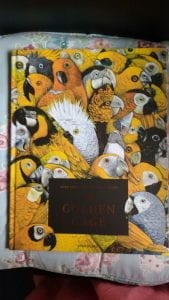 “The Golden Cage” by Anna Castagnoli and Carll Cneut can only be described as a stunning piece of art, but it is also a salutatory lesson in how not to behave towards humans and birds. The story itself is a cautionary tale of a very nasty princess who loves collecting birds, but kills off servants who don’t bring her exactly what she wants. This is very much about what happens when there are no rules, because Princess Valentina is totally spoiled and no one tells her that there are limits on what is possible. The illustrations are amazing; they are vibrant, sophisticated, full of emotion and bring the story to life. There is a very limited colour palette and the strong use of the colour yellow highlights the title of the book and the importance of the ‘golden cage’ as the place where her most treasured acquisition will be held captive. The ending of this fairy tale has been left open, so that we can imagine a variety of plots, to suit our mood. Somehow this reminds me of the Brothers Grimm and I think it will be a great read with older children despite the small amount of text.
“The Golden Cage” by Anna Castagnoli and Carll Cneut can only be described as a stunning piece of art, but it is also a salutatory lesson in how not to behave towards humans and birds. The story itself is a cautionary tale of a very nasty princess who loves collecting birds, but kills off servants who don’t bring her exactly what she wants. This is very much about what happens when there are no rules, because Princess Valentina is totally spoiled and no one tells her that there are limits on what is possible. The illustrations are amazing; they are vibrant, sophisticated, full of emotion and bring the story to life. There is a very limited colour palette and the strong use of the colour yellow highlights the title of the book and the importance of the ‘golden cage’ as the place where her most treasured acquisition will be held captive. The ending of this fairy tale has been left open, so that we can imagine a variety of plots, to suit our mood. Somehow this reminds me of the Brothers Grimm and I think it will be a great read with older children despite the small amount of text.
“Tomorrow” by Nadine Kaadan is a story about living in a war zone and there are moments when it is quite  heartbreaking. The young hero Yazan loves going to the park to play but life suddenly changes and he doesn’t know why. He gets bored not going to school, not meeting his friends and not going out to play, so one day he decides to take his bike to the park; but nothing is as it should be and thankfully his father finds him before anything happens. The illustrations often have a darkness about them that reflects the reality of life that the family are living and Yazan is shown as being a very young child caught up in a dangerous world. This thought provoking book really adds to the collection that is developing and which helps young children understand what it has been like to live in some of the war zones around the world. It will also hopefully help them develop their empathy with those who have lost their homes and had to move to another country.
heartbreaking. The young hero Yazan loves going to the park to play but life suddenly changes and he doesn’t know why. He gets bored not going to school, not meeting his friends and not going out to play, so one day he decides to take his bike to the park; but nothing is as it should be and thankfully his father finds him before anything happens. The illustrations often have a darkness about them that reflects the reality of life that the family are living and Yazan is shown as being a very young child caught up in a dangerous world. This thought provoking book really adds to the collection that is developing and which helps young children understand what it has been like to live in some of the war zones around the world. It will also hopefully help them develop their empathy with those who have lost their homes and had to move to another country.
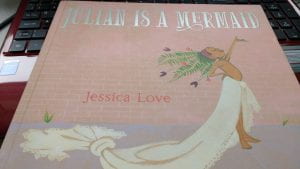 “Julian is a Mermaid” by Jessica Love is a delightful story about being true to yourself and about others accepting that we are all different. When Julian is walking home with his grandma they see a group of ladies dress as mermaids and Julian decides that he want to be one too. At home he finds an assortment of clothes to help in his transformation and even put on some make-up. His Nana reacts in a very supportive way and gives him a bead necklace to finish his look and then they go off on a walk. During this stroll they see a range of very individual and vibrantly dressed people and finally they start to see lots of mermaids; much to Julian’s delight. This is actually a carnival and people are allowing themselves the pleasure of dressing up.It is a delightful way to show the way that a wide range of people can live in harmony and enjoy life.
“Julian is a Mermaid” by Jessica Love is a delightful story about being true to yourself and about others accepting that we are all different. When Julian is walking home with his grandma they see a group of ladies dress as mermaids and Julian decides that he want to be one too. At home he finds an assortment of clothes to help in his transformation and even put on some make-up. His Nana reacts in a very supportive way and gives him a bead necklace to finish his look and then they go off on a walk. During this stroll they see a range of very individual and vibrantly dressed people and finally they start to see lots of mermaids; much to Julian’s delight. This is actually a carnival and people are allowing themselves the pleasure of dressing up.It is a delightful way to show the way that a wide range of people can live in harmony and enjoy life.
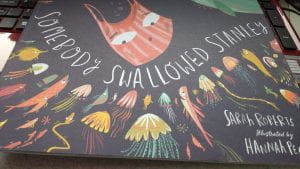 “Somebody swallowed Stanley” by Sarah Roberts and Hannah Peck is a very unusual but very relevant look at plastic waste and the effect on the sea. Stanley is a striped plastic bag and he finds himself blown into the sea where he is in turn swallowed by a Whale, Seagulls and a Turtle; luckily they were able to free themselves, but the Turtle need the help of a young boy. The boy then tells Stanley that he should not be in the sea, because creatures think he looks like a jellyfish. The boy then turns Stanley into a kite which is much more appropriate. This is a very simple story but it acts as a perfect introduction to looking at our environment as well as being a great story.
“Somebody swallowed Stanley” by Sarah Roberts and Hannah Peck is a very unusual but very relevant look at plastic waste and the effect on the sea. Stanley is a striped plastic bag and he finds himself blown into the sea where he is in turn swallowed by a Whale, Seagulls and a Turtle; luckily they were able to free themselves, but the Turtle need the help of a young boy. The boy then tells Stanley that he should not be in the sea, because creatures think he looks like a jellyfish. The boy then turns Stanley into a kite which is much more appropriate. This is a very simple story but it acts as a perfect introduction to looking at our environment as well as being a great story.
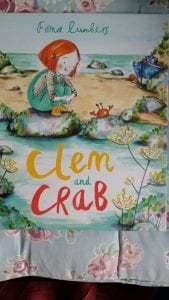 “Clem and Crab” by Fiona Lumbers is another story that helps us look at our environment and in particular the issues that we find along our beaches. Clem loves visiting the beach with her sister and fishing around in the rock pools, searching for wildlife. One day she finds a small crab and although she puts it back into the water, it somehow manages to get caught in her clothing and end off back in the city. Clem would love to keep her new friend but knows it must be returned to the beach; but how can she help make that a safe place for the crab? This is a lovely book at friendship and helping others and would be fantastic if you were planning on visiting the seaside.
“Clem and Crab” by Fiona Lumbers is another story that helps us look at our environment and in particular the issues that we find along our beaches. Clem loves visiting the beach with her sister and fishing around in the rock pools, searching for wildlife. One day she finds a small crab and although she puts it back into the water, it somehow manages to get caught in her clothing and end off back in the city. Clem would love to keep her new friend but knows it must be returned to the beach; but how can she help make that a safe place for the crab? This is a lovely book at friendship and helping others and would be fantastic if you were planning on visiting the seaside.
“I am a Tiger” by Karl Newson and Ross Collins is a delightful story of a mouse who 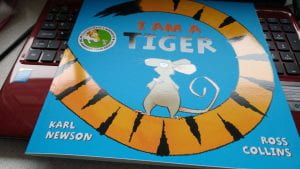 wants everyone to believe that he is a tiger. The absurdity of such a claim becomes apparent as he wanders along and meets a wide range of animals, none of which are correctly identified; this leads them to be sad and frustrated as they try and make this small creature understand who they are. In some ways this has the feel of the Gruffalo as the mouse is walking though the landscape and is telling ‘stories’ to the animals he sees. It is also a story about identity and perhaps about not being limited by our physical appearance. Most of us know who we are but often like to imagine that we have a different persona. I am delighted to find that a follow up called “I am not an Elephant” is scheduled to be published early in 2020, I can’t wait to read this as well.
wants everyone to believe that he is a tiger. The absurdity of such a claim becomes apparent as he wanders along and meets a wide range of animals, none of which are correctly identified; this leads them to be sad and frustrated as they try and make this small creature understand who they are. In some ways this has the feel of the Gruffalo as the mouse is walking though the landscape and is telling ‘stories’ to the animals he sees. It is also a story about identity and perhaps about not being limited by our physical appearance. Most of us know who we are but often like to imagine that we have a different persona. I am delighted to find that a follow up called “I am not an Elephant” is scheduled to be published early in 2020, I can’t wait to read this as well.
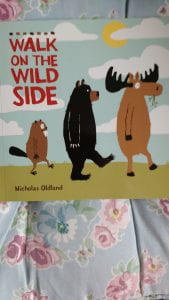 “Walk on the Wild Side” by Nicholas Oldland is the third in a series of adventures featuring Moose, Bear and Beaver. In this story they decide to climb a mountain, but find that it is much harder than they had imagined. After lots of danger and obstacles they discover that the only way to succeed is by helping each other, and then they finally achieve their objective. I love these very simple, humorous stories that each give a very strong message and look forward to many more adventures for the intrepid trio.
“Walk on the Wild Side” by Nicholas Oldland is the third in a series of adventures featuring Moose, Bear and Beaver. In this story they decide to climb a mountain, but find that it is much harder than they had imagined. After lots of danger and obstacles they discover that the only way to succeed is by helping each other, and then they finally achieve their objective. I love these very simple, humorous stories that each give a very strong message and look forward to many more adventures for the intrepid trio.
“The New Neighbours” by Sarah McIntyre tells the story of the what happens when the 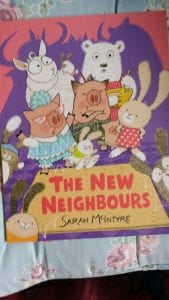 residents of a block of apartments discover that a family of rats have moved in to their building.The bunny children are the first to find out and they are looking forward to going and meeting their new neighbours. But as they tell more people, mainly adults, we see attitudes change as people believe the stereotypes they have heard in the past. Thankfully when they finally meet the neighbours they realize that they are just the same as everyone else. This is a charming story with a strong and very important message about not listening to gossip and not judging people because of their backgrounds. As always Sarah McIntyre’s illustrations are colourful, energetic and funny and it is a great story for reading aloud.
residents of a block of apartments discover that a family of rats have moved in to their building.The bunny children are the first to find out and they are looking forward to going and meeting their new neighbours. But as they tell more people, mainly adults, we see attitudes change as people believe the stereotypes they have heard in the past. Thankfully when they finally meet the neighbours they realize that they are just the same as everyone else. This is a charming story with a strong and very important message about not listening to gossip and not judging people because of their backgrounds. As always Sarah McIntyre’s illustrations are colourful, energetic and funny and it is a great story for reading aloud.
“Cyril and Pat” by Emily Gravett tells the story of Cyril, a grey squirrel who finds himself living alone in the park. Then one day he meets another ‘squirrel’ called Pat and  suddenly he has a friend to share adventures with; however we can see that Pat is actually a rat, not a squirrel. Eventually the other creatures tell Cyril the truth and Pat is forced to leave the park, leaving his friend alone again. The story does have a happy ending and the two are able to resume their friendship despite being different. Emily Gravett has given us a wonderful story of friendship, acceptance and empathy. It is full of humour but also has its fair share of pathos; it is a wonderful tale.
suddenly he has a friend to share adventures with; however we can see that Pat is actually a rat, not a squirrel. Eventually the other creatures tell Cyril the truth and Pat is forced to leave the park, leaving his friend alone again. The story does have a happy ending and the two are able to resume their friendship despite being different. Emily Gravett has given us a wonderful story of friendship, acceptance and empathy. It is full of humour but also has its fair share of pathos; it is a wonderful tale.
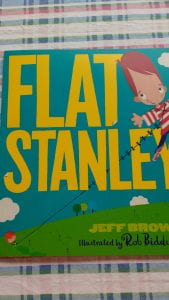 “Flat Stanley” by Jeff Brown and Rob Biddulph was first published in the UK in 1968 and since then it has become a perennial favourite with young children. They love the quirky and imaginative story of a young boy who is squashed flat, but then goes on to have amazing adventures. In this version Stanley saves the museum from robbers and is flown as a kite, however he has to cope with people being mean because he is different. Luckily his brother comes up with a solution and Stanley is pumped back into shape with a bicycle pump. This version of the story is illustrated by Rob Biddulph with his characteristic
“Flat Stanley” by Jeff Brown and Rob Biddulph was first published in the UK in 1968 and since then it has become a perennial favourite with young children. They love the quirky and imaginative story of a young boy who is squashed flat, but then goes on to have amazing adventures. In this version Stanley saves the museum from robbers and is flown as a kite, however he has to cope with people being mean because he is different. Luckily his brother comes up with a solution and Stanley is pumped back into shape with a bicycle pump. This version of the story is illustrated by Rob Biddulph with his characteristic
“Sweep” by Louise Greig and Julia Sarda tells the story of Ed and what happens when he allows his dark and angry feelings to get out of control. There is the wonderful analogy of 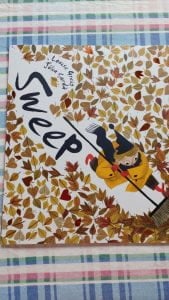 sweeping up dead leaves, but what do we do when they become too many for us to cope with and begin to effect those around us? Luckily a wind comes along and blows away his bad mood and he learns to think twice before allowing it to take over again. This is a very dynamic book with energetic illustrations which really help us visualize the issues that Ed is facing. The story is very simple but absolutely gets its message across; it will be great for helping young children come to terms with their own emotions as well as those of others around them.
sweeping up dead leaves, but what do we do when they become too many for us to cope with and begin to effect those around us? Luckily a wind comes along and blows away his bad mood and he learns to think twice before allowing it to take over again. This is a very dynamic book with energetic illustrations which really help us visualize the issues that Ed is facing. The story is very simple but absolutely gets its message across; it will be great for helping young children come to terms with their own emotions as well as those of others around them.
“There’s Room for Everyone” by Anita Teymorian is a very thought provoking story about our world and about sharing the space that we have. This is something of a  philosophical look at our world and how we seem to always want more space, yet this book reminds us that there is always room for all of us; this includes humans and animals. At a time when there are refugees across the globe, forests are being cut down and housing seems to be at a premium, perhaps we need to remember some of the ideas in this story. The illustrations are sophisticated and get also naive but manage to convey the meaning of the text in a way that we can readily relate to. I am sure this will find its place in the discussions about our world and the way we all live.
philosophical look at our world and how we seem to always want more space, yet this book reminds us that there is always room for all of us; this includes humans and animals. At a time when there are refugees across the globe, forests are being cut down and housing seems to be at a premium, perhaps we need to remember some of the ideas in this story. The illustrations are sophisticated and get also naive but manage to convey the meaning of the text in a way that we can readily relate to. I am sure this will find its place in the discussions about our world and the way we all live.
There are so many amazing new picture books out there that this is just the beginning of my selection. I am busily working on another collection and then there will be some brilliant books for Middle Grade that I hope to highlight in the near future. I have not forgotten about information books and my collection to share with you is growing, so look out for the next selection.
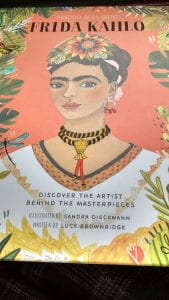 “Frida Kahlo” by Lucy Brownridge and Sandra Dieckmann is a wonderful evocation of the artist’s life and art, aimed at younger children. I have loved her work for a long time, but seeing the exhibition about her life at the V&A in 2018 really brought home how amazing she was. This book mentions her health issues but does not go in to tremendous detail, rather it focuses on her development as an artist and the influence she has had outside Mexico. Sandra Dieckmann has done a tremendous job with the illustrations, bringing her own touches to the work whilst also paying ‘homage’ to Kahlo’s own style. This will make a tremendous addition to any primary school.
“Frida Kahlo” by Lucy Brownridge and Sandra Dieckmann is a wonderful evocation of the artist’s life and art, aimed at younger children. I have loved her work for a long time, but seeing the exhibition about her life at the V&A in 2018 really brought home how amazing she was. This book mentions her health issues but does not go in to tremendous detail, rather it focuses on her development as an artist and the influence she has had outside Mexico. Sandra Dieckmann has done a tremendous job with the illustrations, bringing her own touches to the work whilst also paying ‘homage’ to Kahlo’s own style. This will make a tremendous addition to any primary school. delightful look at coping with a fear of the dark. The young hero finds that he is a ‘bit’ afraid of the dark because of the shadows and various sounds that he cannot identify. So when his father takes him on an overnight camping trip he is really worried by the idea of the dark. However he has a revelation when it is truly dark; for it is then that he can really see all the stars in the night sky. This is a story of finding the beautiful and positive in something that we are not sure about and it is great for young readers. There are lovely illustrations and a really imaginative use of cutouts in many of the pages, which brings everything to life.
delightful look at coping with a fear of the dark. The young hero finds that he is a ‘bit’ afraid of the dark because of the shadows and various sounds that he cannot identify. So when his father takes him on an overnight camping trip he is really worried by the idea of the dark. However he has a revelation when it is truly dark; for it is then that he can really see all the stars in the night sky. This is a story of finding the beautiful and positive in something that we are not sure about and it is great for young readers. There are lovely illustrations and a really imaginative use of cutouts in many of the pages, which brings everything to life.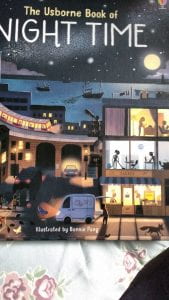 “The Usborne book of Night time” by Usborne and Bonnie Pang is aimed at younger children, perhaps up to lower KS2. It takes the concept of night and then gives us a double page spread to look at the various elements that make up the night. There are factories and cities, the sea and the sky, nocturnal animals, northern lights and different parts of the world; all of these are working while we are sleeping. This is a great introduction to understanding our world and can lead on to some really fascinating discoveries for the young readers.
“The Usborne book of Night time” by Usborne and Bonnie Pang is aimed at younger children, perhaps up to lower KS2. It takes the concept of night and then gives us a double page spread to look at the various elements that make up the night. There are factories and cities, the sea and the sky, nocturnal animals, northern lights and different parts of the world; all of these are working while we are sleeping. This is a great introduction to understanding our world and can lead on to some really fascinating discoveries for the young readers.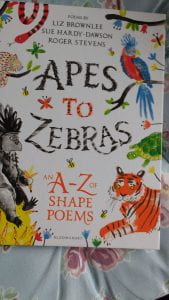 collection of poetry, but importantly it is an A-Z of shape poetry. I think most of us find writing poetry quite challenging, so to find that these poets have created stunning work and all in the shape of various animals is quite amazing. The layout of the book and the simple use of colour really helps the words and shapes stand out but it is the imagination of the writers that really makes this book so stunning.
collection of poetry, but importantly it is an A-Z of shape poetry. I think most of us find writing poetry quite challenging, so to find that these poets have created stunning work and all in the shape of various animals is quite amazing. The layout of the book and the simple use of colour really helps the words and shapes stand out but it is the imagination of the writers that really makes this book so stunning.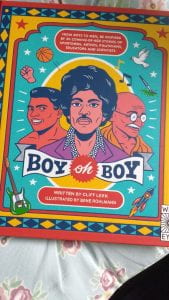 “Boy oh Boy” by Cliff Leek and Bene Rohlmann is a look at 30 men, both living and dead, who have had an impact on the way that we look at men and our expectations of them. Many of these people are household names, but others have not made headlines outside their immediate areas, yet they have had an effect on the way that people think and behave and they have even changed the laws of the land. These people are from around the world and from a wide range of ethnic backgrounds, which shows that everyone has the potential to be great. The illustrations are very bright and strong and are somewhat 1950s in style, making the work stand out from others. After so many books about strong females recently it is good to see a book that looks at broadening the range of biographies.
“Boy oh Boy” by Cliff Leek and Bene Rohlmann is a look at 30 men, both living and dead, who have had an impact on the way that we look at men and our expectations of them. Many of these people are household names, but others have not made headlines outside their immediate areas, yet they have had an effect on the way that people think and behave and they have even changed the laws of the land. These people are from around the world and from a wide range of ethnic backgrounds, which shows that everyone has the potential to be great. The illustrations are very bright and strong and are somewhat 1950s in style, making the work stand out from others. After so many books about strong females recently it is good to see a book that looks at broadening the range of biographies.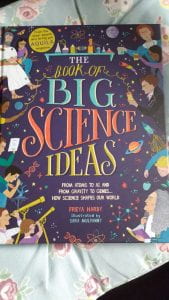 and gives us a double page spread of ‘big thinkers’ in that area and then it looks at the development of our knowledge. Subjects covered vary from the periodic table, animal classification, and astronomy to computers, big data, and renewable energy. Whilst this does not have an index it does have a good glossary which will help the readers understand the new terms thy come across.
and gives us a double page spread of ‘big thinkers’ in that area and then it looks at the development of our knowledge. Subjects covered vary from the periodic table, animal classification, and astronomy to computers, big data, and renewable energy. Whilst this does not have an index it does have a good glossary which will help the readers understand the new terms thy come across.
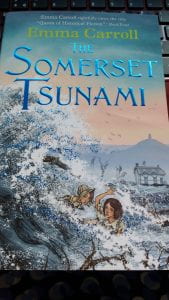 and which affected large parts of the county as well as the area around Newport in South Wales. I remember seeing a programme about this many years ago and can’t wait to read her version of events. Once again the room was packed full of eager readers and then another long queue formed to get books signed. I was also lucky enough to see the amazing Chris Mould in the Green Room, although his session about his new illustrated version of Ted Hughes’ “The Iron Man” was not until after I had
and which affected large parts of the county as well as the area around Newport in South Wales. I remember seeing a programme about this many years ago and can’t wait to read her version of events. Once again the room was packed full of eager readers and then another long queue formed to get books signed. I was also lucky enough to see the amazing Chris Mould in the Green Room, although his session about his new illustrated version of Ted Hughes’ “The Iron Man” was not until after I had  left. However I hear great reports about it and gather there was even a surprise appearance by the totally unique Chris Riddell, who was doing his own event about “Guardians of Magic”, the first in a new series called the ‘Cloud Horse Chronicles’. By the time I left, tiredness was beginning to set in, but it had been a great day.
left. However I hear great reports about it and gather there was even a surprise appearance by the totally unique Chris Riddell, who was doing his own event about “Guardians of Magic”, the first in a new series called the ‘Cloud Horse Chronicles’. By the time I left, tiredness was beginning to set in, but it had been a great day.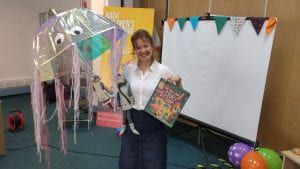 was a craft and reading session with Tracey Corderoy, when she was talking to some very young children and their parents about her book “The One-Stop Story Shop”, illustrated by Tony Neal. There were rhymes, props, singing and lots of glitter and glue. I was amazed by how well prepared Tracey was. There were pre-cut templates, packs of sequins, paper and all the things that were needed, so we didn’t have to go hunting around. This really did make for a stress free event. She also told us about her latest picture book called “Mouse’s Night Before Christmas”, which I have already bought and which will be in the Christmas round up. After this lovely session (which really took me back to the days in a public library) I went down to the Guildhall for my second event. This was with the lovely Abi Elphinstone and she had a couple of hundred school children enthralled by her talk about her books, but particularly about “Rumblestar” the first
was a craft and reading session with Tracey Corderoy, when she was talking to some very young children and their parents about her book “The One-Stop Story Shop”, illustrated by Tony Neal. There were rhymes, props, singing and lots of glitter and glue. I was amazed by how well prepared Tracey was. There were pre-cut templates, packs of sequins, paper and all the things that were needed, so we didn’t have to go hunting around. This really did make for a stress free event. She also told us about her latest picture book called “Mouse’s Night Before Christmas”, which I have already bought and which will be in the Christmas round up. After this lovely session (which really took me back to the days in a public library) I went down to the Guildhall for my second event. This was with the lovely Abi Elphinstone and she had a couple of hundred school children enthralled by her talk about her books, but particularly about “Rumblestar” the first 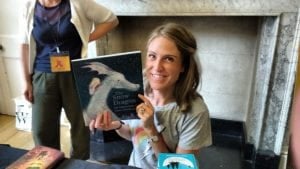 in a magical new series called ‘The Unmapped Chronicles‘. This was an excellent event which the children loved, although I think being shown her very own home-made catapult might have made quite a large impression. This is yet another young writer who is taking the book world by storm and I look forward to following her books over the coming years.
in a magical new series called ‘The Unmapped Chronicles‘. This was an excellent event which the children loved, although I think being shown her very own home-made catapult might have made quite a large impression. This is yet another young writer who is taking the book world by storm and I look forward to following her books over the coming years.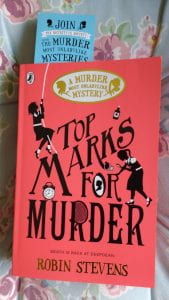 Robin Stevens who was talking about her books ‘Murder Most Unladylike’ and particularly about the new title “Top Marks for Murder”, which once again sees her heroines Daisy and Hazel back at school and facing yet another murder mystery. The idea for the story came to her when she was standing on Bath railway station and saw a couple of people on the hill in the distance; it made her think about seeing a murder, but not being close enough to recognize the murderer and so the plot was conceived. Robin has built up a following of avid readers and they were out in force to get their books signed, some of them bringing their complete collections. I was then scheduled to help with the “Horrid Henry” session with Francesca Simon, which was a packed event and there were loads of excited fans wanting to find out about their unlikely hero. Once again the queues were long and everyone wanted their books signed. I managed to dash downstairs to try and get some books signed by the speakers for another event. They were Catherine Fisher, author of “Clockwork Crow” and
Robin Stevens who was talking about her books ‘Murder Most Unladylike’ and particularly about the new title “Top Marks for Murder”, which once again sees her heroines Daisy and Hazel back at school and facing yet another murder mystery. The idea for the story came to her when she was standing on Bath railway station and saw a couple of people on the hill in the distance; it made her think about seeing a murder, but not being close enough to recognize the murderer and so the plot was conceived. Robin has built up a following of avid readers and they were out in force to get their books signed, some of them bringing their complete collections. I was then scheduled to help with the “Horrid Henry” session with Francesca Simon, which was a packed event and there were loads of excited fans wanting to find out about their unlikely hero. Once again the queues were long and everyone wanted their books signed. I managed to dash downstairs to try and get some books signed by the speakers for another event. They were Catherine Fisher, author of “Clockwork Crow” and 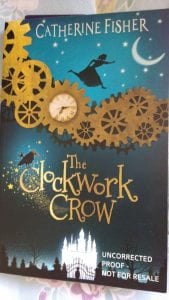 “Velvet Fox” and P.G. Bell who wrote“The Train to
“Velvet Fox” and P.G. Bell who wrote“The Train to 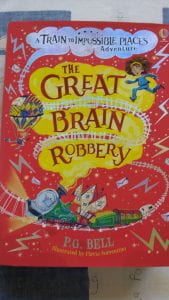 Impossible Places” and now has “The Great Brain Robbery”. I managed to meet Catherine and get my books signed but unfortunately Peter Bell had already left the building. Never mind, I will catch up with him eventually and the books will gain his signature.
Impossible Places” and now has “The Great Brain Robbery”. I managed to meet Catherine and get my books signed but unfortunately Peter Bell had already left the building. Never mind, I will catch up with him eventually and the books will gain his signature.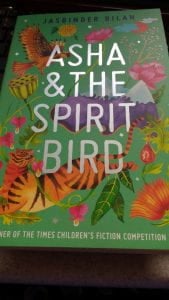 author of “Asha and the Spirit Bird” (and previous winner of the Times Children’s Fiction Competition). This was definitely one for the adults, something that was reflected by the lack of young people in the audience, although the Pillar Room was crammed full of excited adults, some of whom definitely wanted to have their work published. The talk itself was stimulating and reminded me that I have been very lucky over the years to meet many people in publishing, all of whom are generous with their knowledge and experience.
author of “Asha and the Spirit Bird” (and previous winner of the Times Children’s Fiction Competition). This was definitely one for the adults, something that was reflected by the lack of young people in the audience, although the Pillar Room was crammed full of excited adults, some of whom definitely wanted to have their work published. The talk itself was stimulating and reminded me that I have been very lucky over the years to meet many people in publishing, all of whom are generous with their knowledge and experience. was talking to Alex O’Connell, Mat Tobin (Oxford Brookes University) and Clare Pollard, the author of “Fierce Bad Rabbits”, a truly delightful look at picture books. Each of the participants had to choose one title from each of the last seven decades and it was brilliant to see the range that they came up with. Many of the titles I am glad to say were old favourites, some I really must get around to reading and one or two were new to me. The panel also chose a title that they thought might prove to be future classics and although I have not read one of them yet, I think that they are definitely worthy of this accolade. They are “Bearmouth” by Liz Hyder, “Julian is a Mermaid” by Jessica Lowe, “Skylark’s War” by Hilary McKay and “Town is by the Sea” by Joanne Schwartz and Sydney Smith. The second event of the
was talking to Alex O’Connell, Mat Tobin (Oxford Brookes University) and Clare Pollard, the author of “Fierce Bad Rabbits”, a truly delightful look at picture books. Each of the participants had to choose one title from each of the last seven decades and it was brilliant to see the range that they came up with. Many of the titles I am glad to say were old favourites, some I really must get around to reading and one or two were new to me. The panel also chose a title that they thought might prove to be future classics and although I have not read one of them yet, I think that they are definitely worthy of this accolade. They are “Bearmouth” by Liz Hyder, “Julian is a Mermaid” by Jessica Lowe, “Skylark’s War” by Hilary McKay and “Town is by the Sea” by Joanne Schwartz and Sydney Smith. The second event of the 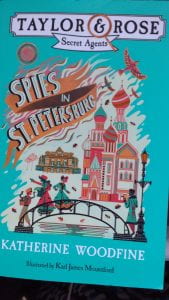 day was entitles “Mysterious Places” and it had been guest curated by Robin Stevens, although she was not able to attend and the wonderful and talented Katherine Woodfine took the role of chair, as well as being one of the authors, talking about “Spies in St Petersburg”. The other speakers were Dominique Valente with her
day was entitles “Mysterious Places” and it had been guest curated by Robin Stevens, although she was not able to attend and the wonderful and talented Katherine Woodfine took the role of chair, as well as being one of the authors, talking about “Spies in St Petersburg”. The other speakers were Dominique Valente with her 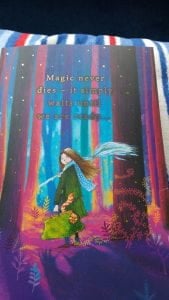 book “Starfell”, which was about magic and what happens when a particular day ceases to exist; Dave Shelton with the first in a series of adventures featuring “Emily Lime, Librarian Detective” and Polly Yo-Hen with her latest novel “Where Monsters Lie”. They spoke about their individual books and specifically how they created the characters and situations, but they also talked about other recent books that they have been influenced by. This was an event that was definitely loved by the young audience and hopefully they will have added some new titles to their
book “Starfell”, which was about magic and what happens when a particular day ceases to exist; Dave Shelton with the first in a series of adventures featuring “Emily Lime, Librarian Detective” and Polly Yo-Hen with her latest novel “Where Monsters Lie”. They spoke about their individual books and specifically how they created the characters and situations, but they also talked about other recent books that they have been influenced by. This was an event that was definitely loved by the young audience and hopefully they will have added some new titles to their 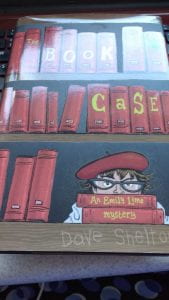 reading lists. The great thing about such panels is that you might go to hear a particular author but you then discover that you might enjoy books by the other participants.
reading lists. The great thing about such panels is that you might go to hear a particular author but you then discover that you might enjoy books by the other participants. “The Golden Cage” by Anna Castagnoli and Carll Cneut can only be described as a stunning piece of art, but it is also a salutatory lesson in how not to behave towards humans and birds. The story itself is a cautionary tale of a very nasty princess who loves collecting birds, but kills off servants who don’t bring her exactly what she wants. This is very much about what happens when there are no rules, because Princess Valentina is totally spoiled and no one tells her that there are limits on what is possible. The illustrations are amazing; they are vibrant, sophisticated, full of emotion and bring the story to life. There is a very limited colour palette and the strong use of the colour yellow highlights the title of the book and the importance of the ‘golden cage’ as the place where her most treasured acquisition will be held captive. The ending of this fairy tale has been left open, so that we can imagine a variety of plots, to suit our mood. Somehow this reminds me of the Brothers Grimm and I think it will be a great read with older children despite the small amount of text.
“The Golden Cage” by Anna Castagnoli and Carll Cneut can only be described as a stunning piece of art, but it is also a salutatory lesson in how not to behave towards humans and birds. The story itself is a cautionary tale of a very nasty princess who loves collecting birds, but kills off servants who don’t bring her exactly what she wants. This is very much about what happens when there are no rules, because Princess Valentina is totally spoiled and no one tells her that there are limits on what is possible. The illustrations are amazing; they are vibrant, sophisticated, full of emotion and bring the story to life. There is a very limited colour palette and the strong use of the colour yellow highlights the title of the book and the importance of the ‘golden cage’ as the place where her most treasured acquisition will be held captive. The ending of this fairy tale has been left open, so that we can imagine a variety of plots, to suit our mood. Somehow this reminds me of the Brothers Grimm and I think it will be a great read with older children despite the small amount of text. heartbreaking. The young hero Yazan loves going to the park to play but life suddenly changes and he doesn’t know why. He gets bored not going to school, not meeting his friends and not going out to play, so one day he decides to take his bike to the park; but nothing is as it should be and thankfully his father finds him before anything happens. The illustrations often have a darkness about them that reflects the reality of life that the family are living and Yazan is shown as being a very young child caught up in a dangerous world. This thought provoking book really adds to the collection that is developing and which helps young children understand what it has been like to live in some of the war zones around the world. It will also hopefully help them develop their empathy with those who have lost their homes and had to move to another country.
heartbreaking. The young hero Yazan loves going to the park to play but life suddenly changes and he doesn’t know why. He gets bored not going to school, not meeting his friends and not going out to play, so one day he decides to take his bike to the park; but nothing is as it should be and thankfully his father finds him before anything happens. The illustrations often have a darkness about them that reflects the reality of life that the family are living and Yazan is shown as being a very young child caught up in a dangerous world. This thought provoking book really adds to the collection that is developing and which helps young children understand what it has been like to live in some of the war zones around the world. It will also hopefully help them develop their empathy with those who have lost their homes and had to move to another country. “Julian is a Mermaid” by Jessica Love is a delightful story about being true to yourself and about others accepting that we are all different. When Julian is walking home with his grandma they see a group of ladies dress as mermaids and Julian decides that he want to be one too. At home he finds an assortment of clothes to help in his transformation and even put on some make-up. His Nana reacts in a very supportive way and gives him a bead necklace to finish his look and then they go off on a walk. During this stroll they see a range of very individual and vibrantly dressed people and finally they start to see lots of mermaids; much to Julian’s delight. This is actually a carnival and people are allowing themselves the pleasure of dressing up.It is a delightful way to show the way that a wide range of people can live in harmony and enjoy life.
“Julian is a Mermaid” by Jessica Love is a delightful story about being true to yourself and about others accepting that we are all different. When Julian is walking home with his grandma they see a group of ladies dress as mermaids and Julian decides that he want to be one too. At home he finds an assortment of clothes to help in his transformation and even put on some make-up. His Nana reacts in a very supportive way and gives him a bead necklace to finish his look and then they go off on a walk. During this stroll they see a range of very individual and vibrantly dressed people and finally they start to see lots of mermaids; much to Julian’s delight. This is actually a carnival and people are allowing themselves the pleasure of dressing up.It is a delightful way to show the way that a wide range of people can live in harmony and enjoy life. “Somebody swallowed Stanley” by Sarah Roberts and Hannah Peck is a very unusual but very relevant look at plastic waste and the effect on the sea. Stanley is a striped plastic bag and he finds himself blown into the sea where he is in turn swallowed by a Whale, Seagulls and a Turtle; luckily they were able to free themselves, but the Turtle need the help of a young boy. The boy then tells Stanley that he should not be in the sea, because creatures think he looks like a jellyfish. The boy then turns Stanley into a kite which is much more appropriate. This is a very simple story but it acts as a perfect introduction to looking at our environment as well as being a great story.
“Somebody swallowed Stanley” by Sarah Roberts and Hannah Peck is a very unusual but very relevant look at plastic waste and the effect on the sea. Stanley is a striped plastic bag and he finds himself blown into the sea where he is in turn swallowed by a Whale, Seagulls and a Turtle; luckily they were able to free themselves, but the Turtle need the help of a young boy. The boy then tells Stanley that he should not be in the sea, because creatures think he looks like a jellyfish. The boy then turns Stanley into a kite which is much more appropriate. This is a very simple story but it acts as a perfect introduction to looking at our environment as well as being a great story. “Clem and Crab” by Fiona Lumbers is another story that helps us look at our environment and in particular the issues that we find along our beaches. Clem loves visiting the beach with her sister and fishing around in the rock pools, searching for wildlife. One day she finds a small crab and although she puts it back into the water, it somehow manages to get caught in her clothing and end off back in the city. Clem would love to keep her new friend but knows it must be returned to the beach; but how can she help make that a safe place for the crab? This is a lovely book at friendship and helping others and would be fantastic if you were planning on visiting the seaside.
“Clem and Crab” by Fiona Lumbers is another story that helps us look at our environment and in particular the issues that we find along our beaches. Clem loves visiting the beach with her sister and fishing around in the rock pools, searching for wildlife. One day she finds a small crab and although she puts it back into the water, it somehow manages to get caught in her clothing and end off back in the city. Clem would love to keep her new friend but knows it must be returned to the beach; but how can she help make that a safe place for the crab? This is a lovely book at friendship and helping others and would be fantastic if you were planning on visiting the seaside. wants everyone to believe that he is a tiger. The absurdity of such a claim becomes apparent as he wanders along and meets a wide range of animals, none of which are correctly identified; this leads them to be sad and frustrated as they try and make this small creature understand who they are. In some ways this has the feel of the Gruffalo as the mouse is walking though the landscape and is telling ‘stories’ to the animals he sees. It is also a story about identity and perhaps about not being limited by our physical appearance. Most of us know who we are but often like to imagine that we have a different persona. I am delighted to find that a follow up called “I am not an Elephant” is scheduled to be published early in 2020, I can’t wait to read this as well.
wants everyone to believe that he is a tiger. The absurdity of such a claim becomes apparent as he wanders along and meets a wide range of animals, none of which are correctly identified; this leads them to be sad and frustrated as they try and make this small creature understand who they are. In some ways this has the feel of the Gruffalo as the mouse is walking though the landscape and is telling ‘stories’ to the animals he sees. It is also a story about identity and perhaps about not being limited by our physical appearance. Most of us know who we are but often like to imagine that we have a different persona. I am delighted to find that a follow up called “I am not an Elephant” is scheduled to be published early in 2020, I can’t wait to read this as well. “Walk on the Wild Side” by Nicholas Oldland is the third in a series of adventures featuring Moose, Bear and Beaver. In this story they decide to climb a mountain, but find that it is much harder than they had imagined. After lots of danger and obstacles they discover that the only way to succeed is by helping each other, and then they finally achieve their objective. I love these very simple, humorous stories that each give a very strong message and look forward to many more adventures for the intrepid trio.
“Walk on the Wild Side” by Nicholas Oldland is the third in a series of adventures featuring Moose, Bear and Beaver. In this story they decide to climb a mountain, but find that it is much harder than they had imagined. After lots of danger and obstacles they discover that the only way to succeed is by helping each other, and then they finally achieve their objective. I love these very simple, humorous stories that each give a very strong message and look forward to many more adventures for the intrepid trio. residents of a block of apartments discover that a family of rats have moved in to their building.The bunny children are the first to find out and they are looking forward to going and meeting their new neighbours. But as they tell more people, mainly adults, we see attitudes change as people believe the stereotypes they have heard in the past. Thankfully when they finally meet the neighbours they realize that they are just the same as everyone else. This is a charming story with a strong and very important message about not listening to gossip and not judging people because of their backgrounds. As always Sarah McIntyre’s illustrations are colourful, energetic and funny and it is a great story for reading aloud.
residents of a block of apartments discover that a family of rats have moved in to their building.The bunny children are the first to find out and they are looking forward to going and meeting their new neighbours. But as they tell more people, mainly adults, we see attitudes change as people believe the stereotypes they have heard in the past. Thankfully when they finally meet the neighbours they realize that they are just the same as everyone else. This is a charming story with a strong and very important message about not listening to gossip and not judging people because of their backgrounds. As always Sarah McIntyre’s illustrations are colourful, energetic and funny and it is a great story for reading aloud. suddenly he has a friend to share adventures with; however we can see that Pat is actually a rat, not a squirrel. Eventually the other creatures tell Cyril the truth and Pat is forced to leave the park, leaving his friend alone again. The story does have a happy ending and the two are able to resume their friendship despite being different. Emily Gravett has given us a wonderful story of friendship, acceptance and empathy. It is full of humour but also has its fair share of pathos; it is a wonderful tale.
suddenly he has a friend to share adventures with; however we can see that Pat is actually a rat, not a squirrel. Eventually the other creatures tell Cyril the truth and Pat is forced to leave the park, leaving his friend alone again. The story does have a happy ending and the two are able to resume their friendship despite being different. Emily Gravett has given us a wonderful story of friendship, acceptance and empathy. It is full of humour but also has its fair share of pathos; it is a wonderful tale. “Flat Stanley” by Jeff Brown and Rob Biddulph was first published in the UK in 1968 and since then it has become a perennial favourite with young children. They love the quirky and imaginative story of a young boy who is squashed flat, but then goes on to have amazing adventures. In this version Stanley saves the museum from robbers and is flown as a kite, however he has to cope with people being mean because he is different. Luckily his brother comes up with a solution and Stanley is pumped back into shape with a bicycle pump. This version of the story is illustrated by Rob Biddulph with his characteristic
“Flat Stanley” by Jeff Brown and Rob Biddulph was first published in the UK in 1968 and since then it has become a perennial favourite with young children. They love the quirky and imaginative story of a young boy who is squashed flat, but then goes on to have amazing adventures. In this version Stanley saves the museum from robbers and is flown as a kite, however he has to cope with people being mean because he is different. Luckily his brother comes up with a solution and Stanley is pumped back into shape with a bicycle pump. This version of the story is illustrated by Rob Biddulph with his characteristic sweeping up dead leaves, but what do we do when they become too many for us to cope with and begin to effect those around us? Luckily a wind comes along and blows away his bad mood and he learns to think twice before allowing it to take over again. This is a very dynamic book with energetic illustrations which really help us visualize the issues that Ed is facing. The story is very simple but absolutely gets its message across; it will be great for helping young children come to terms with their own emotions as well as those of others around them.
sweeping up dead leaves, but what do we do when they become too many for us to cope with and begin to effect those around us? Luckily a wind comes along and blows away his bad mood and he learns to think twice before allowing it to take over again. This is a very dynamic book with energetic illustrations which really help us visualize the issues that Ed is facing. The story is very simple but absolutely gets its message across; it will be great for helping young children come to terms with their own emotions as well as those of others around them. philosophical look at our world and how we seem to always want more space, yet this book reminds us that there is always room for all of us; this includes humans and animals. At a time when there are refugees across the globe, forests are being cut down and housing seems to be at a premium, perhaps we need to remember some of the ideas in this story. The illustrations are sophisticated and get also naive but manage to convey the meaning of the text in a way that we can readily relate to. I am sure this will find its place in the discussions about our world and the way we all live.
philosophical look at our world and how we seem to always want more space, yet this book reminds us that there is always room for all of us; this includes humans and animals. At a time when there are refugees across the globe, forests are being cut down and housing seems to be at a premium, perhaps we need to remember some of the ideas in this story. The illustrations are sophisticated and get also naive but manage to convey the meaning of the text in a way that we can readily relate to. I am sure this will find its place in the discussions about our world and the way we all live.